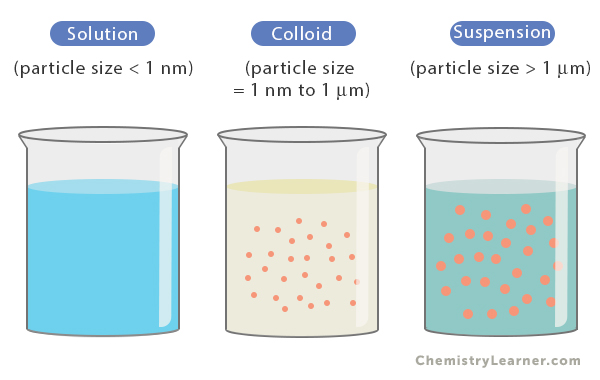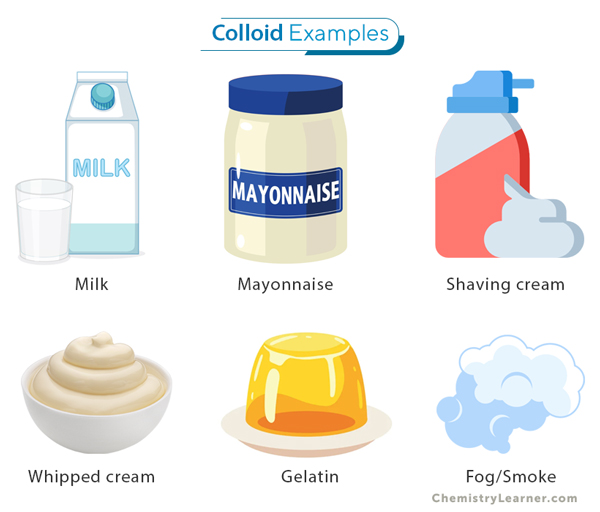Colloids
Colloids are mixtures of two or more substances where one substance is dispersed within another. The dispersed substance is referred to as the “dispersed phase”. The medium in which it is dispersed is known as the “dispersion medium”. [1 – 4]
A colloidal solution typically consists of particles ranging in size from 1 nanometer to 1 micrometer. These particles can be solid, liquid, or gas. Unlike true solutions where solute particles are dissolved at a molecular level, colloidal particles remain suspended in the dispersion medium without settling down due to gravity, thus forming a heterogeneous mixture.
Properties and Applications
The properties of colloids differ from those observed in true solutions or suspensions. For instance, they often display unique optical effects, such as the Tyndall effect, when light passes through them. This phenomenon occurs because the dispersed particles scatter light rays and make them visible. [1]
Colloids find numerous applications across various industries. They are utilized in areas such as food science (e.g., emulsions), pharmaceuticals (e.g., drug delivery systems), cosmetics (e.g., creams), and even environmental engineering (e.g., wastewater treatment). [1,6]
Classification
Colloids are a type of mixture, with one substance dispersed as particles in another substance. These mixtures can be classified based on the particle size and the nature of the dispersed phase. The different categories of colloids include emulsions, foams, aerosols, sols, and gels. [1,2,6]
Emulsions are colloidal systems where liquid droplets are dispersed in another immiscible liquid.
Foams consist of gas bubbles dispersed in a liquid or solid medium. They can be formed by mechanical agitation or trapping gas during formation.
Aerosols refer to colloidal systems where solid or liquid particles are suspended in a gas medium.
Sols are colloidal systems where solid particles are dispersed in a liquid medium. Due to Brownian motion, sols have smaller particle sizes that do not settle over time.
Gels consist of a continuous solid network throughout a liquid medium. The gel network traps the liquid within its structure, giving it a semi-solid consistency.
Colloid Examples
The table below lists a few examples of colloids. [1,3,6]
| Dispersion Medium | Gas Dispersion Phase | Liquid Dispersion Phase | Solid Dispersion Phase |
|---|---|---|---|
| Gas | None | Liquid aerosol (e.g., mist, fog, and cloud) | Solid aerosol (e.g., smoke and dust storms) |
| Liquid | Foam (e.g., soap suds, shaving cream, and whipped cream) | Emulsion (e.g., mayonnaise, milk, and oil on water) | Sol (e.g., pigmented ink, sediment, and paint) |
| Solid | Solid foam (e.g., lava, pumice, and Styrofoam) | Gel (e.g., jelly, gelatin, and agar) | Solid sol (e.g., cranberry glass and ruby glass) |
Preparations
Colloids are created through various techniques, two prominent ones being the condensation method and the dispersion method. [2,6]
Condensation Method
The condensation method initiates particle growth from smaller entities. In this method, molecules or ions in a solution gather and agglomerate, forming larger particles. For instance, the precipitation of silver chloride in a silver nitrate and sodium chloride solution exemplifies the condensation technique. The ions collide, creating tiny solid particles that settle, leaving a dispersed colloid in the solution. Similarly, in aerosols, condensation occurs when vapor condenses into small droplets, suspending in the air as mist or fog.
Dispersion Method
The dispersion method fragments larger particles into smaller ones. It resembles sculpting, where larger chunks are chiseled into intricate shapes. This approach involves breaking down bulkier substances into colloidal particles. An example of the dispersion method is the creation of colloids by mechanical means, like milling or grinding. Breaking down a solid into fine particles and dispersing them in a liquid medium exemplifies this method. Another way to form colloids is by electrical means, like the dispersal of droplets in an emulsion by applying an electric field.






